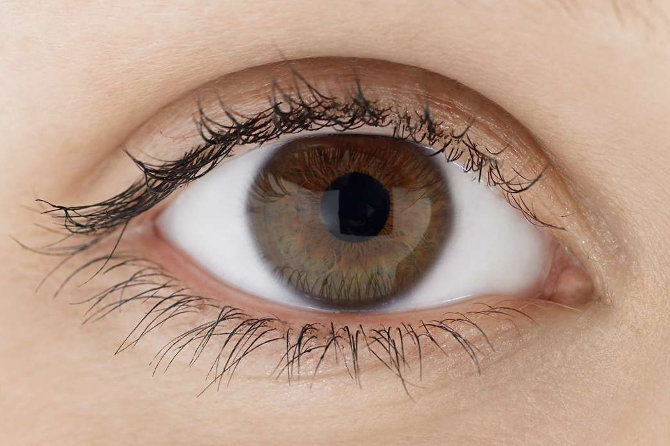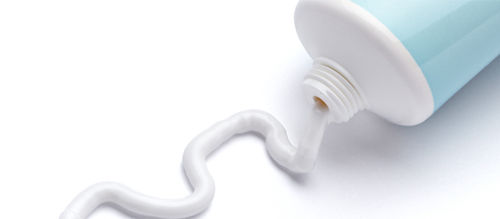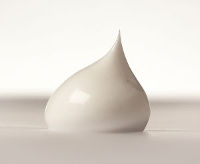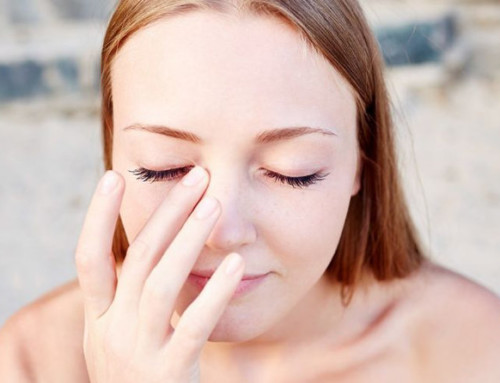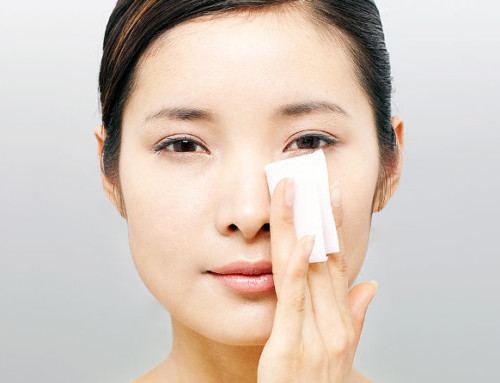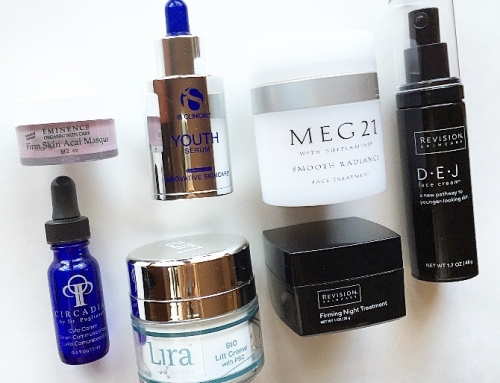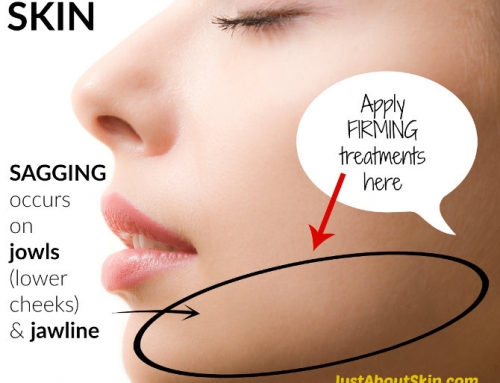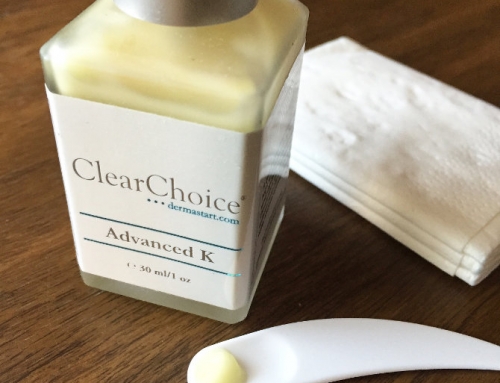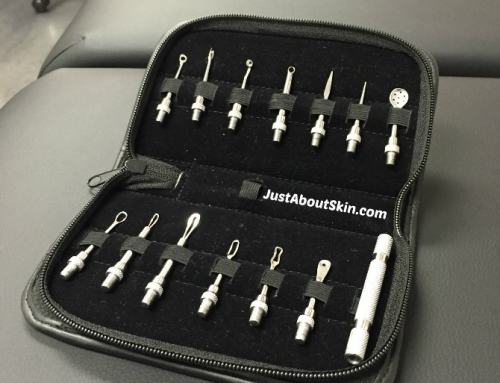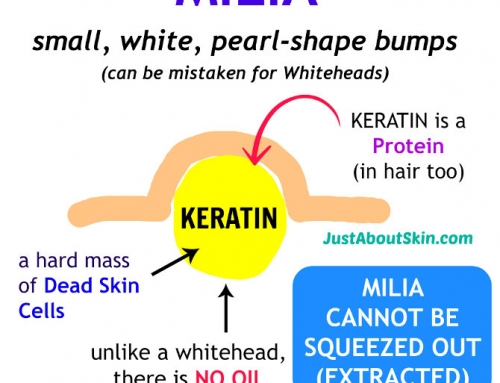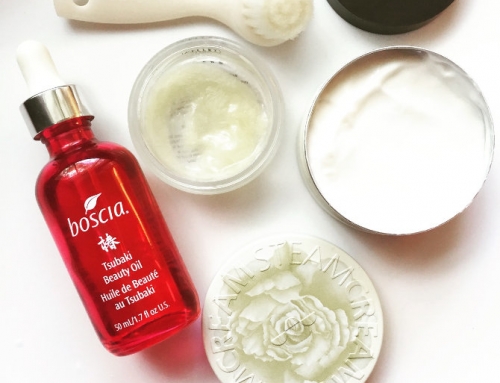My last post was about managing eye irritation, such as a rash around the eyes. Today’s post continues this topic with a focus on how to choose products for irritated eyes – not just what to use, but more importantly, what to avoid.
When the eye area is irritated, the wrong products can make it worse and set you back in healing time.
Since eye irritation is already uncomfortable enough as it is, you want to avoid putting yourself in a situation where you now have to correct the damage caused by a wrong product PLUS the damage caused by the original irritation.
I recommend you read the last post first to get a quick understanding of eye irritation. The tips in that post are related to the product discussion below.
PRODUCTS FOR IRRITATED EYES – WHAT SHOULD I USE?
The simple answer to this – AS LITTLE AS POSSIBLE.
It’s best to leave irritated skin around the eyes alone. Nearly everything will bother irritated eyes.
But the skin around the eyes tends to get dry, so leaving that area ‘naked’ while you’re healing can be uncomfortable too. A little bit of moisturizer can help.
Assuming you have a minor rash, meaning – it’s not serious or infectious (bacterial, viral, or fungal in origin), it’s okay to put something around the eyes as long as it doesn’t bother you.
If a product does bother you, don’t continue using it, even if its purpose is to help you. Discomfort such as itching, stinging, burning, or pain is always a sign to stop. If your skin becomes redder, drier, flakier, scaly, or hardened as a result, that’s also a sign to stop.
A doctor might suggest using an over-the-counter drugstore ointment like Aquaphor or petroleum jelly like Vaseline. Both products are occlusive, and the logic behind using an occlusive product is to protect the skin. These products are thick ointments that cover the skin, prevent moisture loss, and provide an environment that allows healing to proceed faster.
(If you’re groaning at the mention of either product or the thought of petrolatum, and you’re wondering why I’m not – read this post about mineral oil and petrolatum.)
When your skin is irritated, a thick occlusive ointment is great for barrier repair (and wound healing). Yes, it has its downsides of course. Yes, it doesn’t feel nice. Yes, it’s sticky. Yes, it’s shiny. And yes, it may clog up your pores.
Forget about all that. First things first. Heal thyself first!
Health comes before vanity. As I have said before in other posts, don’t worry about getting blemishes when you have a barrier problem (which is what you have whenever skin is irritated). You have a more important, more urgent task. A damaged barrier is the underlying cause of many skin problems. Fix the barrier first. You can always un-clog pores later.
If an ointment product like Aquaphor or Vaseline works (doesn’t irritate your skin) – that’s perfect. Your search is over. You can also try a bland emollient cream found in a drugstore, such as Vanicream and Cerave.
But let’s say these products irritate your skin or you just don’t want to use them. Now what?
THE IDEAL PRODUCTS FOR IRRITATED EYES
If you were born with sensitive skin, then you already know how challenging it is to choose products that don’t irritate your skin.
When you don’t have sensitive skin, choosing products for irritated eyes isn’t easy either. How do you know if something will be ok or make the skin worse? There’s no easy answer, which is why you should default to the least risky course.
The best products for irritated eyes are the simplest ones – basic moisturizers or eye creams. And within these two types of products, the texture (consistency) matters.
When choosing a moisturizer or eye cream, look for a cream texture and avoid gels, lotions or loose, airy creams. Try to find a thick cream with a more solid texture – one that doesn’t jiggle, slide, or move if you shake the container it’s in.
You want something that doesn’t seep into skin quickly or spread easily on its own (see the previous post for more about this concept). A thick cream will take more time to absorb. It may even “sit” on top of skin. That’s actually good in this case.
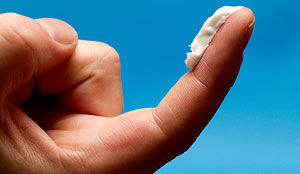 What you really want here is an occlusive layer of cream that reduces moisture loss (by providing that occlusive film over skin) but also feeds the skin with some lipids and provides some lubricating relief for the dryness.
What you really want here is an occlusive layer of cream that reduces moisture loss (by providing that occlusive film over skin) but also feeds the skin with some lipids and provides some lubricating relief for the dryness.
But you don’t want something so thick that you have trouble smoothing it over the eyelids or below the eyes. Some moisturizers and face balms are so thick that the skin tugs from the friction of the cream being dragged across the skin.
If you have this kind of balm-y cream and nothing else, try rubbing it between your fingertips to soften it up first. Then press the balm into skin and hold.
CREAMY MOISTURIZER – BEST OPTION
1. GO BASIC
Now that we’re talking about creams, let’s focus on what kind. There are a gazillion types of moisturizers out there. Fortunately, your task is NOT to find the best anti-aging moisturizer among this gazillion (which is your normal challenge, right?).
Your task is to find the simplest and most boring cream you can find, which is actually not that easy either, given all the hyped-up marketing these days.
Choose the most basic moisturizing cream in your home. And if you don’t have one, go to the drugstore.
Look for VERY BASIC. As in, it has nothing of interest in it. It could be a cream that costs less than $10-15. Drugstore variety. Think Cerave, Cetaphil, Aveeno. The more simple, the better. The cheaper the better (because cheaper generally means no fancy ingredients were used).
2. NO ANTI-AGING PRODUCTS
DO NOT USE ANTI-AGING FACE CREAMS OR EYE CREAMS AROUND IRRITATED EYES. There are too many stimulating or aggressive ingredients in those products that perform an action in skin, such as stimulating collagen production.
Irritated skin doesn’t need further stimulation. It needs the opposite.
Moisturizers that are marketed as barrier repair creams, post-procedure creams, and balms may work. However, I have found this to be hit or miss. Some still irritated my skin. It boils down to what’s inside those creams and your own skin chemistry. Unfortunately, it is impossible to pinpoint what will be problematic and what won’t be for you. Everyone has different skin chemistry.
So the bad news is that finding this basic cream is a trial and error process. And because this is an individual process that only you can determine for yourself, don’t succumb to spending money on expensive products. And don’t try too many products at once. Try one product at a time.
If you’re at a loss for what to try first, and you don’t want a mass market drugstore product, consider barrier repair creams or balms in sensitive skin lines. One that I personally like on myself is Avene, which is more readily available in Europe, but you can order it online in the U.S.
3. ORGANIC DOESN’T MATTER
Organic or non-organic? Doesn’t really matter in my book. Organic may seem healthier or safer. But it doesn’t mean that it won’t have irritating ingredients. It also doesn’t solve the problem that plant-based ingredients pose to people who have sensitivities to specific plant compounds.
In other words, don’t pay a premium for organic products just because they’re organic. Likewise, don’t poo-poo non-organic drugstore products just because they’re cheap or you perceive them to be inferior in quality.
Basic is the keyword here. Seek a no-fuss cream that was designed to do one and only thing – moisturize and nothing else.
EYE CREAMS – BASIC ONLY
Eye creams are tricky. This category of skincare is overwhelming focused on treating wrinkles, dark circles, or puffiness. And all of those concerns involve ingredients that will likely exacerbate irritated eyes. Only a minority of eye creams will just moisturize.
So, avoid eye creams designed for age-fighting. This is even more important if you’re using an eye cream instead of a face cream in the eye area.
Definitely stay away from retinol, peptides, all acids, Vitamin C in the form of ascorbic acid. Even antioxidants (many are plant-based) can be tricky.
A simple, creamy face cream may be a better option than an eye cream. Plus, it’s generally cheaper.
FACE OILS – A TRICKY OPTON
What about oils as an alternative to a face cream or eye cream? Oils are tricky in this situation. While they are very lipid-rich and wonderfully moisturizing and reparative to skin, they can be irritating on an existing rash, especially one near the eyes.
 With an oil, you may encounter the same problem that people with very sensitive skin experience – great difficulty finding plant-derived oils that don’t irritate their skin.
With an oil, you may encounter the same problem that people with very sensitive skin experience – great difficulty finding plant-derived oils that don’t irritate their skin.
The chemical compounds inherently found in plants can be allergens. While an oil will be comprised mostly of lipids, all the parts of the plant that were processed to make the oil release a large range of chemical compounds that can be irritating.
Oils also spread very fast. So the oil can get into your eyes easily and irritate the tissue surrounding the eye ball, not to mention the eyeball itself.
If an oil doesn’t irritate your rash, then adopt a conservative approach to applying it. Use the PRESS METHOD with minimal oil on your finger.
- Don’t pump oil onto your fingertip and then place it directly on skin.
- Instead, pump oil into your palm, dip your finger in the oil fast, let any excess oil drip off, then press onto skin.
- Or better yet, apply a drop of oil to your cheek, rub it in a bit, then move your fingertip (which should still have oil residue) to your eye area and press. This last method ensures a minimal amount of oil is pressed in, and there is less chance of any excess spreading.
SERUMS & TONERS – AVOID
DO NOT USE ANY SERUMS OR TONERS AROUND THE EYES. These liquid products penetrate through the skin too fast and will likely make irritated skin worse. If you feel immediate stinging, burning, or itching, that’s all the sign you need. If you feel it later, that’s another sign to stop.
I experimented with a variety of soothing, calming, and sensitive skin treatment serums and toners while treating my eyes. I wanted to see if any of these treatments (designed for sensitive skin) would actually help in spite of being more penetrable.
NOPE. All it accomplished was making me more uncomfortable and delaying my healing time. All liquid products, even the gentlest ones, made my rash worse (redder or itchier). One application could easily set me back 3 days or more, and I’d have to start all over to get my skin back to its previous state.
The lesson here is that an impaired barrier simply needs to be closed off and allowed to heal.
SUNSCREENS – ONLY MINERAL
If you stay indoors all day, work from home, live in a part of the world where there is little daylight or sun, or it’s a dark cloudy day – skip the sunscreen around the eyes. GASP! (Yes, there are times when the need to prevent wrinkles/sun damage takes a back seat).
If you need to be outside and you feel guilty about leaving your skin unprotected, or it has been too many weeks of ‘naked skin’ – you can apply sunscreen if you have one that doesn’t bother you.
The best kind for irritated skin is a mineral-based sunscreen (the active ingredient is Zinc Oxide and/or Titanium Dioxide).
A mineral sunscreen (also known as a physical sunscreen) is chemically inert and doesn’t react with skin or other products, which is why it’s chosen for sensitive skin. Zinc Oxide helps reduce inflammation too.
A chemical sunscreen, such as one containing Avobenzone, is much more likely to be irritating around the eyes. Avobenzone and other benzone active ingredients can irritate eyes.
When looking for a mineral sunscreen, choose a thick creamy formula, not a liquid or gel sunscreen for the same reasons mentioned above – you don’t want traveling to occur.
Note that some mineral sunscreens can be drying on skin. If you notice a mineral sunscreen drying out the eye skin and leaving you more dry than you started off, you might want to drop the sunscreen. This is a personal choice. Neither scenario is ideal – the tradeoff is dry but protected vs not dry but unprotected. So you have to determine how badly you need the sunscreen vs how much dryness you can tolerate.
If you get your sunscreen from a SPF foundation, tinted moisturizer, BB/CC cream, or cushion compact – avoid the eye area, even if the active sunscreen agents are mineral-based. Color makeup is too much for irritated skin, and it’s one extra thing to remove at night.
BE PATIENT & BE CONSERVATIVE
Healing takes time. Allow yourself at least a few weeks for healing.
Pay close attention to your skin to monitor changes, especially if the skin is getting worse. If there’s no improvement after a month, or if your skin has gotten worse, you should consider seeing a doctor.
I recommend you keep a daily journal. Jot down what products you used that day and the routine (the order that you applied the products). These notes can help you later (if you run into the same issue again), and they can help the professional who helps you. The journal helps identify the trigger (if there is one) and the resulting outcome of that trigger.
When we use multiple skincare products in our daily life, it’s very easy to lose track of what we used. It’s not exactly important information that gets stored in our brain’s long-term memory. Your recollection becomes a blur after a week.
Good luck to you if you are experiencing a rash. The good news is that your skin is a robust organ that is designed to repair itself. If allowed to heal without interference, it will!
Want new articles delivered straight to your inbox? Sign up here.
Related Reading:

